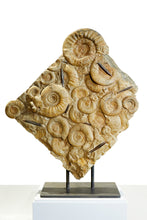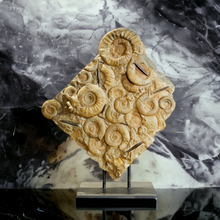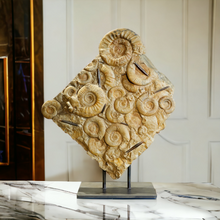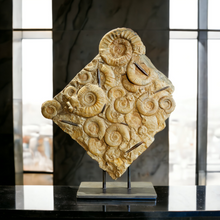- Origin: Drügendorf, Franken, Bavaria, Germany
- Size: H83cm W62cm D25cm
- Description: From the Upper Jurassic period.
Orthosphinctes sp. | Malm gamma 1
Found in the 1980s, this fascinating specimen originates from a quarry which is no longer operating. Giving the appearance of a mosaic, the specimen is completely original and not reconstructed. With its dense, natural arrangement of ammonites this fine mass mortality plate possesses ammonites of various sizes, the largest, diameter 21 cm. It displays the unusual feature of having numerous belemnites as well with the longest belemnite, measuring length 9 cm. The fossil belemnites were replaced by aragonite rather than the limestone of the rest of the fossil, and were subsequently prepared and polished to reveal their warm brown colors. Specimen measuring 50 x 57 x 10 cm. Offered with a custom fitted stand. - Additional information: Ammonites were predatory mollusks that resembled a squid with a shell. These cephalopods had eyes, tentacles, and spiral shells. They are more closely related to a living octopus, though the shells resemble that of a nautilus. True ammonites appeared in the fossil record about 240 million years ago. The last lineages disappeared 65 million years ago at the end of the Cretaceous.








